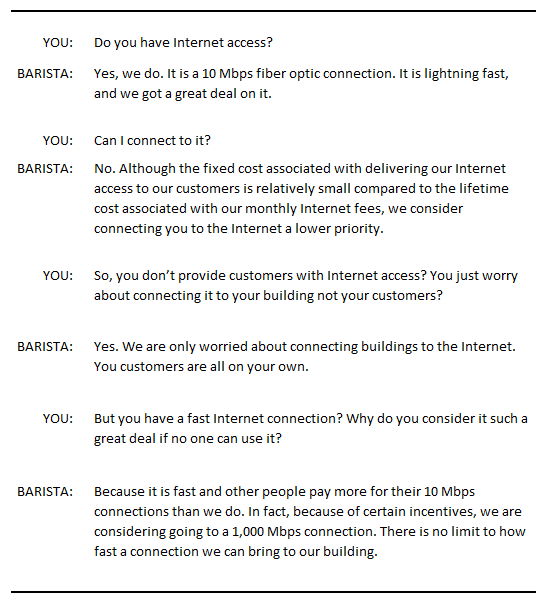Unlimited funding for Internet access and certain telecommunications services is being promoted by some within the education community as the solution to reforming the E-rate program. I admit that “no limits” has a certain allure to it, but can the FCC really promise unlimited support for certain services? The annual E-rate budget is capped at $2.25 billion each year (plus an inflation adjustment). I find it odd that anyone with a capped budget could promise an endless supply of anything.
Of course, the proponents of unlimited support are not referring to Internet access in the colloquial sense. They do not define Internet access from the perspective of a student or library patron. They use regulatory definitions that stop the Internet access at the curb, or the front door of the building, as if what happens beyond that point is a lower priority.
Let me illustrate. Assume you are getting a cup of coffee at a local coffee shop*. You walk in, pull out your iPad and try to connect to the Wi-Fi. Initially, you do not get a signal but eventually you connect to the Wi-Fi but without any access to the Internet. You go up to the barista:

*I recommend you try Northside Social, but that has nothing to do with this illustration.
The E-rate program is capped. No matter how much money there is available, it will not be an unlimited supply. Someone will be told “no” for something. It might be nice or politically expedient to act like we can promise unlimited funding for certain services, but the fact remains that there are limits.
Today, those limits are drawn at the street, like a digital divide at the front door of the school. Why isn’t funding provided to support Wi-Fi in our neediest schools? Is it so we can subsidize Internet access at wealthy schools? Is it because paying telecomm carriers and Internet providers is more important? That makes no sense. There are numerous other ways that funds could be prioritized. For example:
- Need of the applicant
- Location of the applicant
- Size of the applicant
- Cost-effectiveness of a solution
- Timeliness of a funding application
These are all potential ways to prioritize E-rate funding. (The Funds For Learning E-rate 2.0 proposal is built around these very principles.)
But whether or not you agree with this specific set of priority factors, would you agree with me that E-rate dollars should be prioritized based on the needs of students and library patrons? I propose that we reframe the E-rate reform discussion and focus it on how best to manage a limited amount of funding. That is a productive, and I think, more realistic approach to tackling E-rate reform.
